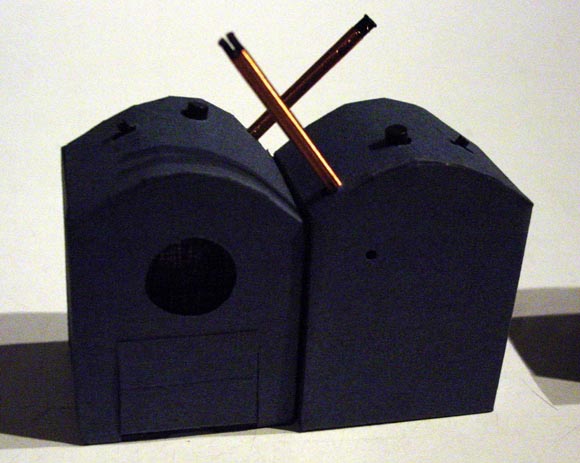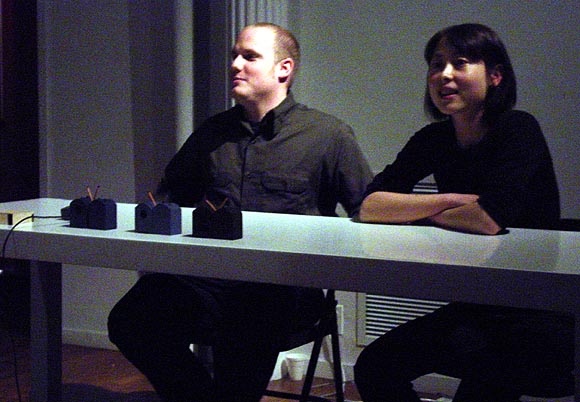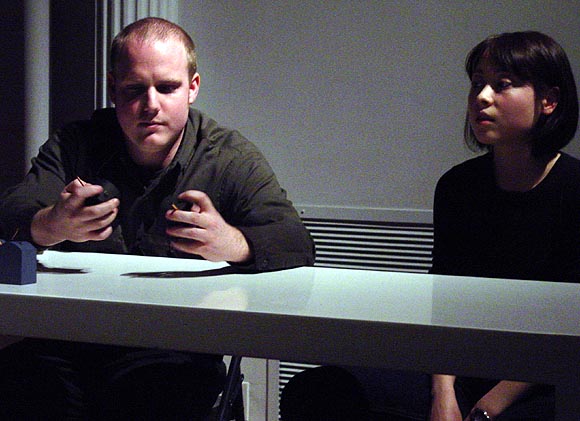
This weblog will no longer be updated. It consists almost entirely of posts on music recycled from my main blog. I had hopes that I could maintain it with independent content but something has to give. ![]() Commencing this month, .mp3s of my own music (and video) will be posted at tommoody.us, a page I created for files that hog space and bandwidth.
Commencing this month, .mp3s of my own music (and video) will be posted at tommoody.us, a page I created for files that hog space and bandwidth.
Stephen Malinowski has posted streaming vids of his Music Animation Machine, something he developed on his own using DOS programming while the music and graphic worlds continued to change all around him. Fans of Oskar Fischinger (the pioneer, art Deco music animator hired and fired for Disney's Fantasia) and Edward Tufte (the design guru who shows you how to present visual information cleanly and logically) should both be impressed by this project. Compositions by Bach, Beethoven, etc. slowly scroll left to right in a notation that looks like a MIDI editing grid, reduced to a range of basic colors against a black field; the parts playing in the exact present are highlighted in the center. The idea is to give the viewer an intuitive sense of what's happening in music, ostensibly for educational purposes, but I'd say they are basically artworks on the synesthetic frontier, tickling those synapses where musical and visual pleasure responses precisely overlap.
 Only one of the videos posted is Malinowski's own music, and it hints at creative possibilities for his medium that go beyond just animating the old masters. In the middle of the scroll (somewhere to the right of the screen shot here) occurs a dense Lego-like clump that goes on for just about as long as the ear wants to hear pure Lego, before returning to the tonal main theme. The intentional pushing and pulling between eye and ear-related expectations in a completely intuitively comprehensible way is an area that ought to be explored more. (Hat tip for the link to Cory Arcangel, whose own work deals with similar issues on an aggressive, cinematic scale, and with electro instead of Beethoven.)
Only one of the videos posted is Malinowski's own music, and it hints at creative possibilities for his medium that go beyond just animating the old masters. In the middle of the scroll (somewhere to the right of the screen shot here) occurs a dense Lego-like clump that goes on for just about as long as the ear wants to hear pure Lego, before returning to the tonal main theme. The intentional pushing and pulling between eye and ear-related expectations in a completely intuitively comprehensible way is an area that ought to be explored more. (Hat tip for the link to Cory Arcangel, whose own work deals with similar issues on an aggressive, cinematic scale, and with electro instead of Beethoven.)I've decided all my music is going to be under a minute now.
"Mister Arkadin" [mp3 removed] (with fadeout) / [mp3 removed] (loop)
Some may snicker at the news that Thomas Dolby has become a high paid ringtone producer: the articles I read dismissed him as a one-hit wonder from the '80s fallen on hard times. Yeah, I guess that's the case if you buy into media-driven, late capitalist notions of success. One could see it differently: that The Golden Age of Wireless (the LP that preceded his hit EP by a year or so) is as original as Bowie's Hunky Dory and will continue to be listened to for its soulful melodies, smart lyrics and innovative synth programming (to the extent the tech is dated it's interestingly dated), and as for the ringtones, assuming they're original compositions, he just found another way for companies to mass-distribute his art. You can hear incipient ringtones all through Golden Age, for example, the opening bars of "Flying North" and "Cloudburst at Shingle Street."
In the '50s, a time of postwar optimism and faith in science, there was Hi-Fi. In the '90s, an era of slackers and diminished expectations, there was Lo-Fi. In the '00s, a time of neanderthal government and outright contempt for the arts, there is Neg-Fi. A watershed moment in the history of art and music--some might say sub-nadir--was reached tonight when this New York noise-rock duo demonstrated its Wireless UFDs (uncontrollable feedback devices) to an audience of 100 or so at Dorkbot-NYC. Walkie talkies from the dollar store have been reinstalled in custom cardboard cases. When placed in proximity to each other and turned on, they make squealing and static noises. And that's about it!



Neg-Fi's cassettes and art objects are available through La Superette, which is currently having a Valentines' Day sale. Also on the Dorkbot program tonight were Aaron Yassin, who digitally assembles plein air photos of architecture into seductive tiled patterns reminiscent of Islamic mosaics and Gothic stained glass, and Jason Freeman, who recently had a piece performed at Carnegie Hall in which an orchestra played notes based on the rate at which concertgoers turned on and off glow sticks. The somber 20th Century classical sounds made by the players, reading from a score digitally translating from the blinking lights, seemed even more sedate considering the stick-waving rave taking place in the audience.